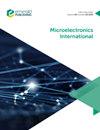温度辅助HiPIMS技术改善c轴(002)AlN晶面
IF 0.8
4区 工程技术
Q4 ENGINEERING, ELECTRICAL & ELECTRONIC
引用次数: 1
摘要
目的研究高功率脉冲磁控溅射(HiPIMS)技术在硅衬底上首次沉积氮化铝(AlN)薄膜时温度的影响。设计/方法/方法使用HiPIMS系统在200的低输出功率下沉积AlN薄膜 W.将倾斜温度从室温引入衬底,最高温度为100°Cat,即薄膜的初始沉积,并将结果与无额外热量的溅射薄膜进行比较。对于热辅助AlN沉积,使衬底在剩余的沉积时间内冷却至室温。用X射线衍射(XRD)和原子力显微镜(AFM)对薄膜进行了表征,用两点探针法通过电流-电压响应研究了MIS肖特基二极管的特性。XRD图谱显示,AlN薄膜的c轴(002)择优取向的强峰显著改善。在温度辅助下,观察到峰变窄,其中计算的FWHM为0.35°,而在室温下沉积的AlN薄膜的FWHM约为0.59°。在温度辅助的情况下,体相薄膜的结晶度提高了28%。AFM图像显示出显著的改善,因为在0.7左右实现了低表面粗糙度 温度辅助样品的nm与3 nm,而不施加热量。独创性/价值引入衬底的少量热量显著改善了c轴AlN薄膜的生长,这种方法有利于在低温工艺下沉积高质量的薄膜。本文章由计算机程序翻译,如有差异,请以英文原文为准。
Improvement of c-axis (002) AlN crystal plane by temperature assisted HiPIMS technique
PurposeThis study aims to investigate the effect of temperature applied at the initial deposition of Aluminium Nitride (AlN) thin-film on a silicon substrate by high-power impulse magnetron sputtering (HiPIMS) technique.
Design/methodology/approachHiPIMS system was used to deposit AlN thin film at a low output power of 200 W. The ramping temperature was introduced to substrate from room temperature to maximum 100°Cat the initial deposition of thin-film, and the result was compared to thin-film sputtered with no additional heat. For the heat assistance AlN deposition, the substrate was let to cool down to room temperature for the remaining deposition time. The thin-films were characterized by X-ray diffraction (XRD) and atomic force microscope (AFM) while the MIS Schottky diode characteristic investigated through current-voltage response by a two-point probe method.
FindingsThe XRD pattern shows significant improvement of the strong peak of the c-axis (002) preferred orientation of the AlN thin-film. The peak was observed narrowed with temperature assisted where FWHM calculated at 0.35° compared to FWHM of AlN thin film deposited at room temperature at around 0.59°. The degree of crystallinity of bulk thin film was improved by 28% with temperature assisted. The AFM images show significant improvement as low surface roughness achieved at around 0.7 nm for temperature assisted sample compares to 3 nm with no heat applied.
Originality/valueThe small amount of heat introduced to the substrate has significantly improved the growth of the c-axis AlN thin film, and this method is favorable in the deposition of the high-quality thin film at the low-temperature process.
求助全文
通过发布文献求助,成功后即可免费获取论文全文。
去求助
来源期刊

Microelectronics International
工程技术-材料科学:综合
CiteScore
1.90
自引率
9.10%
发文量
28
审稿时长
>12 weeks
期刊介绍:
Microelectronics International provides an authoritative, international and independent forum for the critical evaluation and dissemination of research and development, applications, processes and current practices relating to advanced packaging, micro-circuit engineering, interconnection, semiconductor technology and systems engineering. It represents a current, comprehensive and practical information tool. The Editor, Dr John Atkinson, welcomes contributions to the journal including technical papers, research papers, case studies and review papers for publication. Please view the Author Guidelines for further details.
Microelectronics International comprises a multi-disciplinary study of the key technologies and related issues associated with the design, manufacture, assembly and various applications of miniaturized electronic devices and advanced packages. Among the broad range of topics covered are:
• Advanced packaging
• Ceramics
• Chip attachment
• Chip on board (COB)
• Chip scale packaging
• Flexible substrates
• MEMS
• Micro-circuit technology
• Microelectronic materials
• Multichip modules (MCMs)
• Organic/polymer electronics
• Printed electronics
• Semiconductor technology
• Solid state sensors
• Thermal management
• Thick/thin film technology
• Wafer scale processing.
 求助内容:
求助内容: 应助结果提醒方式:
应助结果提醒方式:


